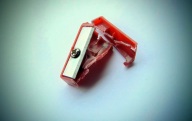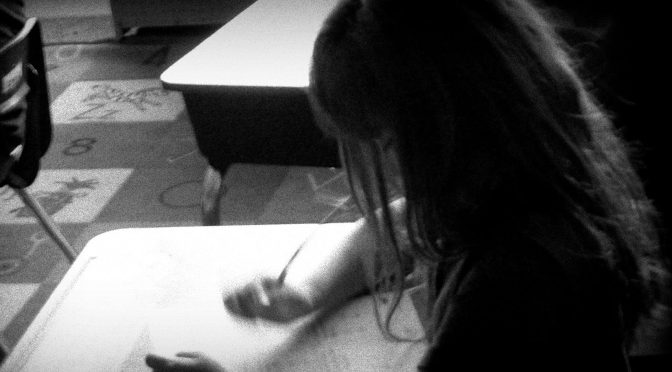.
Ashley struggles in school.
Her struggles relate directly to her unaddressed developmental trauma.
Cognitive and academic impacts of developmental trauma were outlined in “Ashley’s “Normal” Education, Part 1,” HERE.
Ashley’s education has included, her parents’ divorce, her stepfather’s mental health issues, her mother’s angry abuse, her grandmother’s alcoholism and living every day in one of the highest violence and crime neighborhoods in our city.
Brain science informs us that Ashley, and millions of others like her, won’t “just get over it.”
Neuroscientists have found that developmental trauma changes the physical architecture of her developing brain.
.
Damaged cognition is only Part 1.
.
Neurobiology further reveals that nature also fuels Ashley’s social hyper-vigilance, which is a second equally powerful impact: Part 2.
Fear and stress kickstart Ashley’s amygdala, the part of her brain that assesses potential threats and begins the biological stress response. The response includes releasing the chemicals cortisol and adrenaline, increased heart rate, increased blood pressure, slowed digestion, and increased breathing — all to generate a super-energy burst for “fight or flight”.
Chronic developmental trauma can trigger the stress response so often that it becomes the default. Ashley’s neurobiology is changed
Ashley is always on ‘hi alert’, even when there is no threat. It’s like the volume control on her thoughts and assumptions is broken. Therefore, Ashley often misreads social cues. Her fears and her distorted perceptions then alter her behaviors.
Often, Ashley’s fear is set off by an undetectable antecedent, or ‘trigger’, such as a classmate’s slight shift in position, or the most innocent comment or look. More about “triggers” HERE.
Ashley’s hyper-vigilant scanning for any threat she might perceive in the classroom creates a wall between Ashley and others. It serves her well on the streets in her crime-ridden neighborhood, but she can’t “just turn it off.” It’s especially frustrating and dysfunctional in the classroom.
Sometimes Ashley tries to disconnect from the fear by simply putting her head down on her desk and dissociating from all around her.
Sometimes Ashley goes the other way and sits underneath her desk. From there she often tries to distract herself (and us) from her fears with seemingly out-of-the-blue, totally unrelated behavior: maybe interrupting class with a random awkward screech, maybe about what she saw the Principal do yesterday, or angry epitaphs about the weather. Sometimes fully screaming, running, baiting others to enrage and engage in a physical release of her emotion.
Ashley’s social behaviors are frustrating for all of us and, on the surface, they just do not seem to make sense.
Ashley’s defensive behaviors make her seem unpredictable and unsafe to her peers. She does occasionally form short-term liaisons with other trauma-impacted classmates, but they don’t last long. The mutual distrust means Ashley doesn’t have close friendships.
Sadly, behaviors like Ashley’s are many times diagnosed as “focus” issues — ADHD — without making any connection to her trauma history. Going further, inappropriate medication is sometimes prescribed. Later the impacts of developmental trauma are often ‘self-medicated’ with a variety of addictive behaviors.
.
Meanwhile, the combination of Ashley’s logical, nature-driven, cognitive and behavioral defenses to developmental trauma make classroom learning virtually impossible.
.
Ashley is not unusual.
In our high stress, high violence urban neighborhood, forty-five+% of students in our classrooms are impacted by trauma. Ashley is only one of 13 or 14 children struggling in our class of 28.
They struggle academically and socially, year after year, with three+ childhood traumas.
Experiencing three or more ACEs is significant. On top of Ashley’s academic results outlined earlier in Part 1, the three+ ACEs correlate, over a lifetime, with doubled risk of depression, adolescent pregnancy, lung disease, and liver disease. It triples the risk of alcoholism and STDs. There is a 5X increase in attempted suicide.
Individual “504 Plans” are not a solution, given the wide scope: two out of 3 children are injured by at least one at least ACE. Yet, childhood trauma is the “elephant in the [class]room!”
So, we look in the wrong places to understand Ashley and the millions like her and their education “results”: comparisons to “national standards” (with unequal local funding), and meaningless ‘standardized (SES) scores’.
Making Ashley feel safe, physically, emotionally, socially and more is crucial. Ashley’s academic results will suffer and probably decline further until we help address her fears.
.
.
Schools are not trauma-informed.
Experts describe childhood trauma as a ‘national crisis’, an ‘epidemic’. Meanwhile, Ashley is losing her right to equal access. Equal Access to an education.
It’s morally wrong.
It’s urgent.
Trauma-Informed adults CAN make a difference.
.
Get Informed. Click on links below.
.
.
“Like” us at “Trauma-Informed Schools” on Facebook
.
This was only Part 2 of Ashley’s struggle with Trauma’s damage.
Social impacts are only one part of trauma’s damage. Neurobiology reveals that nature also fuels cognitive impairment, a second equally powerful impact on Ashley.
CLICK HERE for Part 1, the cognitive part of Ashley’s struggle. “Nowhere to Hide: Ashley’s “Normal” Education?” , Part 1.
.
.
NCTSN “ToolKit” of Trauma Impacts CLICK HERE
.
How trauma ‘gets under the skin’: Biological and cognitive processes of child maltreatment CLICK HERE (PAGEs 6- 7)
.
Understanding the Behavioral and Emotional Consequences of Child Abuse CLICK HERE
.
Toxic stress changes brain architecture CLICK HERE (2 minute video)
.
Helping trauma-impacted children learn CLICK HERE
.
“Like” us at “Trauma-Informed Pedagogy” on Facebook
.
.
.
.
.
Look for other parts of this series “Nowhere to Hide” on LucidWitness.com for more information.
.
“Nowhere to Hide” series overview
click HERE

“Nowhere to Hide” series links
Each separate, individual article in the series focuses on a single component of the workings of developmental trauma, via real life examples in short “60 second” soundbites, akin to “Public Service Announcements” (PSAs). They are designed for sharing in social media networks to grow public awareness.
Trigger warning:
The children’s experiences in the vignettes are unvarnished. Their traumatic responses may trigger painful memories.
.
“PSA” Links for social media
.
Nowhere to Hide: Maria; Fight, flight or freeze

Nowhere to Hide: Andre’s Fear; What are Adverse Childhood Experiences?

Nowhere to Hide: Jamar’s Hyper-arousal

Nowhere to Hide: Roberto’s Dissociation

Nowhere to Hide: Danny’s Memory

Nowhere to Hide: Ashley’s “Normal” Education? Part 1

Nowhere to Hide: Ashley’s “Normal” Education? Part 2

More to come
.
“Like” us at “Trauma-Informed Pedagogy” on Facebook
.
Please share a PSA link to help grow public awareness of the impacts of developmental trauma. There are so many of us who’ve never heard of the overpowering life-long impacts.
.
“Peek Inside a Classroom” series overview
The second original series, “Peek Inside a Classroom”, provides much more detailed looks inside my classroom, primarily focused on specific students: Jasmine, Danny and José.
Other children are captured in broader looks at education reform concepts: “Failing Schools or Failing Paradigm?” and “Effective Education Reform”, co-authored with Sandra L. Bloom, M. D..
.
“Peek Inside a Classroom” series links
.
Peek Inside a Classroom: Jasmine

Peek Inside a Classroom: Danny


Peek Inside a Classroom: Failing Schools or Failing Paradigm?
Peek Inside a Classroom: Effective Education Reform (with Sandra Bloom, M.D.)
.
“Click for Resources…” series overview:
“Click for Resources” posts are the theory and research behind the narrative posts in “Nowhere to Hide” and “Peek Inside a Classroom”.
Each post in “Click for Resources “ is divided in three parts:
1) general press articles,
2) Research Journals or academic papers
3) social media, often with video.
.
“Click for Resources” series links:
.
1. Adverse Childhood Experience (ACE) Studies: CLICK HERE
2. Impacts of Childhood Trauma: Overview CLICK HERE
Click for Resources: Social Media on Impacts of Childhood Trauma
Click for Resources: Journal Articles on Impacts of Developmental Trauma
3. Trauma-Informed Schools CLICK HERE

4. Trauma-Informed Social Services CLICK HERE

5. Trauma-Informed Juvenile Justice CLICK HERE

6. Trauma-Informed Public Policy CLICK HERE

7. Childhood Trauma Training and Tools CLICK HERE

8. Book and Publication selections CLICK HERE

9. #800 phone numbers CLICK HERE

Developmental trauma, still “the elephant in the [class] room” for many adults.
.
“Like” us at “Trauma-Informed Pedagogy” on Facebook
.
.









You continue to be a passionate voice for precious, vulnerable children. Thank you.
Diane
________________________________
LikeLiked by 1 person
Thank you Diane. You and IFP get a lot of credit for any ‘education’ in the passionate voice.
LikeLike